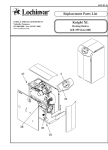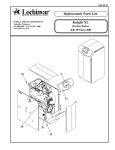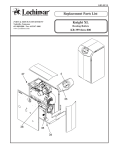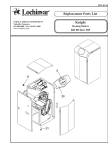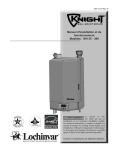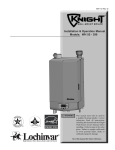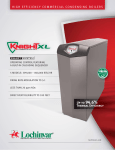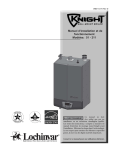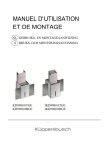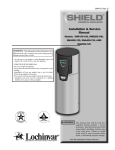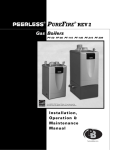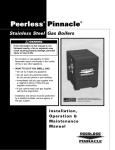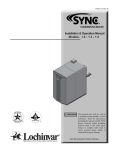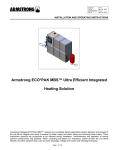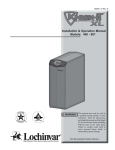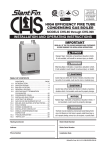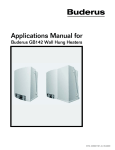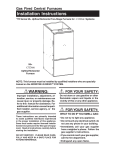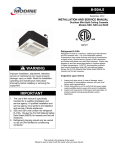Download Knight High Efficiency Condensing Boiler I&O Manual Pg.1-34
Transcript
Installation & Operation Manual Models: 80 - 500 WARNING This manual must only be used by a qualified heating installer / service technician. Read all instructions, including this manual and the Knight Boiler Service Manual, before installing. Perform steps in the order given. Failure to comply could result in severe personal injury, death, or substantial property damage. Save this manual for future reference. Installation & Operation Manual Contents Hazard definitions . . . . . . . . . . . . . . . . . . . . . . . . . . . . . . . . . . . . . . . . . . . . . . . . 2 Please read before proceeding . . . . . . . . . . . . . . . . . . . . . . . . . . . . . . . . . . . . . . 3 The Knight Boiler -- How it works . . . . . . . . . . . . . . . . . . . . . . . . . . . . . . . . . . . . 4 Ratings . . . . . . . . . . . . . . . . . . . . . . . . . . . . . . . . . . . . . . . . . . . . . . . . . . . . . . . . . 7 1. Determine boiler location . . . . . . . . . . . . . . . . . . . . . . . . . . . . . . . . . . . . . . . . 8 2. Prepare boiler . . . . . . . . . . . . . . . . . . . . . . . . . . . . . . . . . . . . . . . . . . . . . . . . . 12 3. General venting . . . . . . . . . . . . . . . . . . . . . . . . . . . . . . . . . . . . . . . . . . . . . . . . 14 4. Sidewall direct venting . . . . . . . . . . . . . . . . . . . . . . . . . . . . . . . . . . . . . . . . . . 18 5. Vertical direct venting . . . . . . . . . . . . . . . . . . . . . . . . . . . . . . . . . . . . . . . . . . 24 6. Hydronic piping . . . . . . . . . . . . . . . . . . . . . . . . . . . . . . . . . . . . . . . . . . . . . . . . 28 7. Gas connections . . . . . . . . . . . . . . . . . . . . . . . . . . . . . . . . . . . . . . . . . . . . . . . 38 8. Field wiring . . . . . . . . . . . . . . . . . . . . . . . . . . . . . . . . . . . . . . . . . . . . . . . . . . . 42 9. Condensate disposal . . . . . . . . . . . . . . . . . . . . . . . . . . . . . . . . . . . . . . . . . . . . 46 10. Start-up . . . . . . . . . . . . . . . . . . . . . . . . . . . . . . . . . . . . . . . . . . . . . . . . . . . . . . 47 11. Operating information . . . . . . . . . . . . . . . . . . . . . . . . . . . . . . . . . . . . . . . . . . 54 12. Notes page . . . . . . . . . . . . . . . . . . . . . . . . . . . . . . . . . . . . . . . . . . . . . . . . . . . 66 Hazard definitions The following defined terms are used throughout this manual to bring attention to the presence of hazards of various risk levels or to important information concerning the life of the product. DANGER DANGER indicates an imminently hazardous situation which, if not avoided, will result in death or serious injury. WARNING WARNING indicates a potentially hazardous situation which, if not avoided, could result in death or serious injury. CAUTION indicates a potentially hazardous situation which, if not avoided, may result in minor or CAUTION moderate injury. CAUTION NOTICE 2 CAUTION used without the safety alert symbol indicates a potentially hazardous situation which, if not avoided, may result in property damage. NOTICE indicates special instructions on installation, operation, or maintenance that are important but not related to personal injury or property damage. Installation & Operation Manual Please read before proceeding WARNING Installer – Read all instructions, including this manual and the Knight Boiler Service Manual, before installing. Perform steps in the order given. User – This manual is for use only by a qualified heating installer/service technician. Refer to the User’s Information Manual for your reference. NOTICE • To avoid electric shock, disconnect electrical supply before performing maintenance. • To avoid severe burns, allow boiler to cool before performing maintenance. Boiler operation – Have this boiler serviced/inspected by a qualified service technician, at least annually. • Do not block flow of combustion or ventilation air to the boiler. Failure to comply with the above could result in severe personal injury, death or substantial property damage. • Should overheating occur or gas supply fail to shut off, do not turn off or disconnect electrical supply to circulator. Instead, shut off the gas supply at a location external to the appliance. When calling or writing about the boiler – Please have the boiler model and serial number from the boiler rating plate. Consider piping and installation when determining boiler location. Any claims for damage or shortage in shipment must be filed immediately against the transportation company by the consignee. Factory warranty (shipped with unit) does not apply to units improperly installed or improperly operated. WARNING When servicing boiler – Failure to adhere to the guidelines on this page can result in severe personal injury, death, or substantial property damage. WARNING If the information in this manual is not followed exactly, a fire or explosion may result causing property damage, personal injury or loss of life. This appliance MUST NOT be installed in any location where gasoline or flammable vapors are likely to be present. WHAT TO DO IF YOU SMELL GAS • Do not try to light any appliance. • Do not touch any electric switch; do not use any phone in your building. • Immediately call your gas supplier from a neighbor’s phone. Follow the gas supplier’s instructions. • If you cannot reach your gas supplier, call the fire department. • Installation and service must be performed by a qualified installer, service agency, or the gas supplier. • Do not use this boiler if any part has been under water. The possible damage to a flooded appliance can be extensive and present numerous safety hazards. Any appliance that has been under water must be replaced. Boiler water – • Thoroughly flush the system (without boiler connected) to remove sediment. The high-efficiency heat exchanger can be damaged by build-up or corrosion due to sediment. • Do not use petroleum-based cleaning or sealing compounds in the boiler system. Gaskets and seals in the system may be damaged. This can result in substantial property damage. • Do not use “homemade cures” or “boiler patent medicines”. Serious damage to the boiler, personnel, and/or property may result. • Continual fresh make-up water will reduce boiler life. Mineral buildup in the heat exchanger reduces heat transfer, overheats the stainless steel heat exchanger, and causes failure. Addition of oxygen carried in by makeup water can cause internal corrosion. Leaks in boiler or piping must be repaired at once to prevent makeup water. Freeze protection fluids – • NEVER use automotive antifreeze. Use only inhibited propylene glycol solutions, which are specifically formulated for hydronic systems. Ethylene glycol is toxic and can attack gaskets and seals used in hydronic systems. 3 Installation & Operation Manual The Knight Boiler - How it works... 1. Stainless steel heat exchanger Allows system water to flow through specially designed coils for maximum heat transfer, while providing protection against flue gas corrosion. The coils are encased in a jacket that contains the combustion process. 2. Heat exchanger access cover Allows access to the combustion side of the heat exchanger coils. 3. Blower The blower pulls in air and gas through the venturi (item 5). Air and gas mix inside the blower and are pushed into the burner, where they burn inside the combustion chamber. 4. Gas valve The gas valve senses the negative pressure created by the blower, allowing gas to flow only if the gas valve is powered and combustion air is flowing. 5. Venturi The venturi controls air and gas flow into the burner. 6. Flue gas sensor This sensor monitors the flue gas exit temperature. The control module will modulate and shut down the boiler if flue gas temperature gets too hot. This protects the flue pipe from overheating. 7. Boiler outlet temperature sensor This sensor monitors boiler outlet water temperature (system supply). If selected as the controlling sensor, the control module adjusts boiler firing rate so the outlet temperature is correct. 8. Boiler inlet temperature sensor This sensor monitors return water temperature (system return). If selected as the controlling sensor, the control module adjusts the boiler firing rate so the inlet temperature is correct. 9. Temperature and pressure gauge (field installed, not shown) Monitors the outlet temperature of the boiler as well as the system water pressure. 10. Electronic display The electronic display consists of 7 buttons and a dual line 32character liquid crystal display. 11. Flue pipe adapter Allows for the connection of the PVC vent pipe system to the boiler. 12. Burner (not shown) Made with metal fiber and stainless steel construction, the burner uses pre-mixed air and gas and provides a wide range of firing rates. 13. Water outlet (system supply) NPT water connection that supplies hot water to the system, either 1", 1-1/4", or 1-1/2", depending on the model. 14. Water inlet (system return) NPT water connection that returns water from the system to the heat exchanger, either 1", 1-1/4", or 1-1/2", depending on the model. 15. Gas connection pipe Threaded pipe connection, either 1/2", 3/4", or 1", depending on the model. This pipe should be connected to the incoming gas supply for the purpose of delivering gas to the boiler. 4 16. SMART Control Module The SMART Control responds to internal and external signals and controls the blower, gas valve, and pumps to meet the heating demand. 17. Automatic air vent Designed to remove trapped air from the heat exchanger coils. 18. Air intake adapter Allows for the connection of the PVC air intake pipe to the boiler. 19. High voltage junction box The junction box contains the connection points for the line voltage power and all pumps. 20. Boiler drain port Location from which the heat exchanger can be drained. 21. Low voltage connection board The connection board is used to connect external low voltage devices. 22. Low voltage wiring connections (knockouts) Conduit connection connection board. points for the low voltage 23. Condensate drain connection Connects the condensate drain line to a 1/2" PVC union. 24. Access cover - front Provides access to the gas train and the heat exchanger. 25. Ignition electrode Provides direct spark for igniting the burner. 26. Flame inspection window The quartz glass window provides a view of the burner surface and flame. 27. Gas shutoff valve Manual valve used to isolate the gas valve from the gas supply. 28. High limit sensor Device that monitors the outlet water temperature. If the temperature exceeds its setting, it will break the control circuit, shutting the boiler down. 29. Relief valve Protects the heat exchanger from an over pressure condition. The relief valve may be set at 30 psi or 50 psi depending on model. 30. Flame sensor Used by the control module to detect the presence of burner flame. 31. Line voltage wiring connections (knockouts) Conduit connection points for the high voltage junction box. 32. Top panel Removable panel to gain access to the internal components. 33. Power switch Turns 120 VAC ON/OFF to the boiler. 34. Leveling legs Used to allow the heat exchanger to be leveled. This is needed for the proper draining of the condensate from the combustion chamber. Installation & Operation Manual The Knight Boiler - How it works... (continued) Models 80 - 210 Figure 1 Front View - Models 80 - 210 Figure 2 Rear View - Models 80 - 210 Figure 3 Left Side (inside unit) - Models 80 - 210 Figure 4 Right Side (inside unit) - Models 80 - 210 5 Installation & Operation Manual The Knight Boiler - How it works... Models 285 - 399 Figure 5 Rear View - Models 285 - 399 Figure 6 Left Side (inside unit) - Models 285 - 399 Model 500 Figure 7 Rear View - Model 500 6 Figure 8 Left Side (inside unit) - Model 500 Installation & Operation Manual Ratings Model Number Lochinvar Low Temperature Boiler Water Water Content Application Connections Gallons Annual Efficiency % CSA Input Modulation Btu/hr DOE Heating Capacity Btu/hr Net I=B=R Ratings Btu/hr DOE AFUE % Note: Change “N” to “L” for L.P. gas models. (Note 6) (Note 2, 9) (Note 3, 9) (Note 1, 9) (Note 5) KBN080 16,000 - 80,000 73,000 63,000 93.0 98.0 0.6 1" 1/2" 3" KBN105 21,000 - 105,000 95,000 83,000 93.0 98.0 0.7 1" 1/2" 3" KBN150 30,000 - 150,000 136,000 118,000 93.0 98.0 1.3 1" 1/2" 3" KBN210 42,000 - 210,000 191,000 166,000 93.0 98.0 1.7 1" 1/2" 3" KBN285 57,000 - 285,000 259,000 225,000 93.0 98.0 2.4 1-1/4" 3/4" 4" Model Number Note: Change “N” to “L” for L.P. gas models. CSA Input Modulation Btu/hr (Note 6) Gross Output, Btu/hr Gas Vent/Air Size Connections (Note 4) Net I=B=R Lochinvar Low Boiler Ratings Combustion Thermal Water Gas Vent/Air Temperature Efficiency Water Connections Connections Size Btu/hr Efficiency % Efficiency % Combustion Thermal Content % % Gallons (Note 6, 9) (Note 3, 9) (Note 7, 9) (Note 7, 9) (Note 8) (Note 8) (Note 4) KBN399 80,000 - 399,000 360,000 313,000 92.2 90.3 95.4 94.5 3.4 1-1/2" 1" 4" KBN500 100,000 - 500,000 451,000 392,000 92.2 90.3 95.4 94.5 4.2 1-1/2" 1" 4" NOTICE Maximum allowed working pressure is located on the rating plate. Notes: 1. As an Energy Star Partner, Lochinvar has determined that Knight boilers meet the Energy Star guidelines for energy efficiency. 2. The ratings are based on standard test procedures prescribed by the United States Department of Energy. 3. Net I=B=R ratings are based on net installed radiation of sufficient quantity for the requirements of the building and nothing need be added for normal piping and pickup. Ratings are based on a piping and pickup allowance of 1.15. 4. Knight boilers require special gas venting. Use only the vent materials and methods specified in the Knight Installation and Operation Manual. 5. Lochinvar’s Low Temperature Application Annual Efficiency is based on ASHRAE 103 test method, using a boiler return water temperature of 90°F, with a boiler outlet water temperature of 110°F. This rating was conducted by Lochinvar. 6. The Knight boiler is equipped for operation up to 2000 feet. For operation at elevations above 2000 feet, the appliance output ratings shall be reduced at a rate of 4% for each 1000 feet above sea level. However, operation of the Knight boiler between 2000 - 4000 feet elevation requires no field adjustments. For operation above 4000 feet elevation, consult the manufacturer. WARNING DO NOT install high altitude models below 4000 feet. 7. Combustion and Thermal Efficiency based on I=B=R testing and rating procedure BTS-2000. 8. Lochinvar's Low Temperature Efficiency is based on I=B=R test method BTS-2000, using a boiler return water temperature of 90°F, with boiler outlet water temperature of 110°F. This rating was conducted by Lochinvar. 9. Ratings have been confirmed by the Hydronics Institute, Division of GAMA. 7 Installation & Operation Manual 1 Determine boiler location Installation must comply with: • Local, state, provincial, and national codes, laws, regulations, and ordinances. • National Fuel Gas Code, ANSI Z223.1 – latest edition. • Standard for Controls and Safety Devices for Automatically Fired Boilers, ANSI/ASME CSD-1, when required. • National Electrical Code. • For Canada only: B149.1 or B149.2 Installation Code, CSA C22.1 Canadian Electrical Code Part 1 and any local codes. NOTICE WARNING Failure to install the appliance indoors could result in severe personal injury, death, or substantial property damage. WARNING The Knight boiler gas manifold and controls met safe lighting and other performance criteria when the boiler underwent tests specified in ANSI Z21.13 – latest edition. Before locating the boiler, check: 1. 2. 3. Check for nearby connection to: • System water piping • Venting connections • Gas supply piping • Electrical power Locate the appliance so that if water connections should leak, water damage will not occur. When such locations cannot be avoided, it is recommended that a suitable drain pan, adequately drained, be installed under the appliance. The pan must not restrict combustion air flow. Under no circumstances is the manufacturer to be held responsible for water damage in connection with this appliance, or any of its components. Check area around the boiler. Remove any combustible materials, gasoline and other flammable liquids. WARNING Failure to keep boiler area clear and free of combustible materials, gasoline, and other flammable liquids and vapors can result in severe personal injury, death, or substantial property damage. 4. The Knight boiler must be installed so that gas control system components are protected from dripping or spraying water or rain during operation or service. 5. If a new boiler will replace an existing boiler, check for and correct system problems, such as: • System leaks causing oxygen corrosion or heat exchanger cracks from hard water deposits. • Incorrectly-sized expansion tank. • Lack of freeze protection in boiler water causing system and boiler to freeze and leak. 8 This appliance is certified as an indoor appliance. Do not install the appliance outdoors or locate where the appliance will be exposed to freezing temperatures or to temperatures that exceed 100°F. This appliance requires a special venting system. The vent connection to the appliance must be made with the starter CPVC pipe section provided with the appliance. The field provided vent fittings must be cemented to the CPVC pipe section. Use only the vent materials, primer and cement specified in this manual to make the vent connections. Failure to follow this warning could result in fire, personal injury, or death. Closet installations WARNING For closet installations as shown in FIG. 9, CPVC vent material must be used (at least in the closet structure). The two ventilating air openings shown in FIG. 9 are required for this arrangement. Failure to follow this warning could result in fire, personal injury, or death. Alcove installations For alcove installations as shown in FIG. 10, PVC vent material can be used with the required clearances and an open front. Provide clearances: Clearances from combustible materials 1. Hot water pipes—at least 1" from combustible materials. 2. Vent pipe – at least 1" from combustible materials. 3. See FIG.’s 9 and 10 on page 9 for other clearance minimums. Clearances for service access 1. See FIG.’s 9 and 10 on page 9 for recommended service clearances. If you do not provide the minimum clearances shown, it may not be possible to service the boiler without removing it from the space. Installation & Operation Manual 1 Determine boiler location (continued) Figure 9 Closet Installation - Minimum Required Clearances WARNING For closet installations, CPVC material MUST BE used in a closet structure. Failure to follow this warning could result in fire, personal injury, or death. Figure 10 Alcove Installation - Minimum Required Clearances 9 Installation & Operation Manual 1 Determine boiler location Provide air openings to room: Residential garage installation Knight boiler alone in boiler room Precautions 1. No air ventilation openings into the boiler room are needed when clearances around the Knight boiler are at least equal to the SERVICE clearances shown in FIG.’s 9 and 10. For spaces that do NOT supply this clearance, provide two openings as shown in FIG. 9. Each opening must provide one square inch free area per 1,000 Btu/hr of boiler input. Take the following special precautions when installing the boiler in a residential garage. If the boiler is located in a residential garage, per ANSI Z223.1, paragraph 5.1.9: Knight boiler in same space with other gas or oilfired appliances • Locate or protect the boiler so it cannot be damaged by a moving vehicle. 1. Follow the National Fuel Gas Code (U.S.) or CSA B149.1 and B149.2 (Canada) to size/verify size of the combustion/ventilation air openings into the space. WARNING The space must be provided with combustion/ventilation air openings correctly sized for all other appliances located in the same space as the Knight boiler. Do not install the boiler in an attic. Failure to comply with the above warnings could result in severe personal injury, death, or substantial property damage. 2. Size openings only on the basis of the other appliances in the space. No additional air opening free area is needed for the Knight boiler because it takes its combustion air from outside (direct vent installation). Flooring and foundation The Knight boiler is approved for installation on combustible flooring, but must never be installed on carpeting. Do not install the boiler on carpeting even if foundation is used. Fire can result, causing severe personal injury, death, or substantial property damage. If flooding is possible, elevate the boiler sufficiently to prevent water from reaching the boiler. 10 Vent and air piping The Knight boiler requires a special vent system, designed for pressurized venting. You must also install air piping from outside to the boiler air intake adapter. The resultant installation is direct vent (sealed combustion). Note prevention of combustion air contamination below when considering vent/air termination. Vent and air must terminate near one another and may be vented vertically through the roof or out a side wall. You may use any of the vent/air piping methods covered in this manual. Do not attempt to install the Knight boiler using any other means. Be sure to locate the boiler such that the vent and air piping can be routed through the building and properly terminated. The vent/air piping lengths, routing and termination method must all comply with the methods and limits given in this manual. Prevent combustion air contamination Flooring WARNING • Mount the boiler with a minimum of 18 inches above the floor of the garage to the bottom of the boiler to ensure the burner and ignition devices will be no less than 18 inches above the floor. Install air inlet piping for the Knight boiler as described in this manual. Do not terminate vent/air in locations that can allow contamination of combustion air. Refer to Table 1, page 11 for products and areas which may cause contaminated combustion air. WARNING You must pipe combustion air to the boiler air intake. Ensure that the combustion air will not contain any of the contaminants in Table 1, page 11. Contaminated combustion air will damage the boiler, resulting in possible severe personal injury, death or substantial property damage. Do not pipe combustion air near a swimming pool, for example. Also, avoid areas subject to exhaust fumes from laundry facilities. These areas will always contain contaminants. Installation & Operation Manual 1 Determine boiler location Table 1 Corrosive Contaminants and Sources Products to avoid: (continued) When removing a boiler from existing common vent system: DANGER Spray cans containing chloro/fluorocarbons Permanent wave solutions Chlorinated waxes/cleaners Chlorine-based swimming pool chemicals Do not install the Knight boiler into a common vent with any other appliance. This will cause flue gas spillage or appliance malfunction, resulting in possible severe personal injury, death, or substantial property damage. Hydrochloric acid/muriatic acid Failure to follow all instructions can result in flue gas spillage and carbon monoxide emissions, causing severe personal injury or death. At the time of removal of an existing boiler, the following steps shall be followed with each appliance remaining connected to the common venting system placed in operation, while the other appliances remaining connected to the common venting system are not in operation. Cements and glues a. Seal any unused openings in the common venting system. Calcium chloride used for thawing Sodium chloride used for water softening Refrigerant leaks Paint or varnish removers Antistatic fabric softeners used in clothes dryers Chlorine-type bleaches, detergents, and cleaning solvents found in household laundry rooms Adhesives used to fasten building products and other similar products WARNING b. Visually inspect the venting system for proper size and horizontal pitch and determine there is no blockage or restriction, leakage, corrosion, or other deficiencies, which could cause an unsafe condition. c. Areas likely to have contaminants Dry cleaning/laundry areas and establishments Swimming pools Metal fabrication plants Beauty shops Test vent system – Insofar as is practical, close all building doors and windows and all doors between the space in which the appliances remaining connected to the common venting system are located and other spaces of the building. Turn on clothes dryers and any appliance not connected to the common venting system. Turn on any exhaust fans, such as range hoods and bathroom exhausts, so they will operate at maximum speed. Do not operate a summer exhaust fan. Close fireplace dampers. Refrigeration repair shops d. Place in operation the appliance being inspected. Follow the lighting instructions. Adjust thermostat so appliance will operate continuously. Photo processing plants e. Test for spillage at the draft hood relief opening after 5 minutes of main burner operation. Use the flame of a match or candle, or smoke from a cigarette, cigar, or pipe. f. After it has been determined that each appliance remaining connected to the common venting system properly vents when tested as outlined herein, return doors, windows, exhaust fans, fireplace dampers, and any other gas-burning appliance to their previous conditions of use. Auto body shops Plastic manufacturing plants Furniture refinishing areas and establishments New building construction Remodeling areas Garages with workshops g. Any improper operation of the common venting system should be corrected so the installation conforms with the National Fuel Gas Code, ANSI Z223.1/NFPA 54 and/or CAN/CSA B149.1, Natural Gas and Propane Installation Code. When resizing any portion of the common venting system, the common venting system should be resized to approach the minimum size as determined using the appropriate tables in Part 11 of the National Fuel Gas Code, ANSI Z223.1/NFPA and/or CAN/CSA B149.1, Natural Gas and Propane Installation Code. 11 Installation & Operation Manual 2 Prepare boiler Remove boiler from wood pallet 1. After removing the outer shipping carton from the boiler, remove the parts box. 2. Remove the front door to access the lag bolts in front of the unit (FIG. 11). 3. To remove the boiler from the pallet (after removing the front door): a. Remove the two lag bolts from the wood pallet inside the boiler (FIG. 11). b. Detach the boiler from the lag bolts in the rear of the unit, see FIG. 11. NOTICE Do not drop the boiler or bump the jacket on the floor or pallet. Damage to the boiler can result. Figure 11 Boiler Mounted on Shipping Pallet Table 2 LP Conversion Table LP Conversion Table Model LP Orifice Stamping 80 80 105 105 150 150 210 210 285 285 399 7.2 Models 80 - 285 1. Remove the top and front access covers from the unit (no tools required for removal). 2. Remove the three star-drive screws securing the gas valve to the venturi (FIG. 12). 3. Locate the propane orifice disk from the conversion kit bag. Verify that the stamping on the orifice disk matches the boiler size (80 – 285) (see Table 2 above). Place the orifice into the black rubber grommet in the side of the gas valve and secure in the valve (FIG. 12). 4. Reposition the gas valve against the venturi and replace the star-drive screws (FIG. 12) securing the valve to the venturi. Gas conversions WARNING For a boiler already installed, you must turn off gas supply, turn off power and allow boiler to cool before proceeding. You must also completely test the boiler after conversion to verify performance as described under Start-up, Section 10 of this manual. You must install the propane orifice to fire the Knight boiler on propane. Verify when installing that the orifice size marking matches boiler size (Models 80 – 399, Table 2). Failure to comply could result in severe personal injury, death, or substantial property damage. 12 5. After installation is complete, attach the propane conversion label (in the conversion kit bag) next to the boiler rating plate. Attach the LP caution label (in the conversion kit bag) to the left side of the unit in the lower left corner. 6. Replace the top and front access covers. Figure 12 Installing Propane Orifice - Models 80 - 285 Installation & Operation Manual 2 Prepare boiler (continued) Model 399 Model 500 1. Remove the top and front access covers from the unit (no tools required for removal). 2. Remove the three screws securing the venturi to the blower. Note: When separating the venturi from the blower, take care not to damage the O-ring inside the blower (FIG. 13). 3. Remove the four star-drive screws securing the gas valve to the venturi (FIG. 13). 4. Locate the propane orifice disk from the conversion kit bag. Verify that the stamping on the orifice disk matches the boiler size (399) (see Table 2 on page 12). 5. Remove the existing orifice from the black rubber grommet in the side of the gas valve and replace it with the orifice from the kit. Position and secure the orifice in the valve as shown in FIG. 13. 6. Reposition the gas valve against the venturi and replace the star-drive screws (FIG. 13) securing the valve to the venturi. 7. Inspect the O-ring inside the blower. Handle the O-ring with care, do not damage. Reposition the venturi against the blower and replace the screws securing the venturi to the blower (FIG. 13). 8. After installation is complete, attach the propane conversion label (in the conversion kit bag) next to the boiler rating plate. Attach the LP caution label (in the conversion kit bag) to the left side of the unit in the lower left corner. 9. Replace the top and front access covers. 1. Remove the top access cover from the unit (no tools required for removal). 2. Remove the cover on top of the gas valve (FIG. 14). 3. Turn the adjustment screw on top of the gas valve one revolution counterclockwise (see FIG. 14). 4. Use a combustion analyzer to verify CO2 is within the range of 9.6 – 10.2%. If not, adjust the screw clockwise incrementally to raise CO2 and counterclockwise to lower CO2 (FIG. 14). 5. After adjustment is complete, attach the propane conversion label (in the conversion kit bag) next to the boiler rating plate. Attach the LP caution label (in the conversion kit bag) to the left side of the unit in the lower left corner. 6. Replace the gas valve cover along with the top access cover. Figure 14 Gas Valve Adjustment - Model 500 Knight 399: Inspect the O-ring when the blower is disassembled. The O-ring must be in good condition and must be installed. Failure to comply will cause a gas leak, Leveling the boiler resulting in severe personal injury or death. 1. Set the boiler in place and check level. a) Adjust legs if necessary to level boiler, see FIG. 15 Figure 13 Installing Propane Orifice - Model 399 below. DANGER Figure 15 Leveling Legs on the Boiler 13 Installation & Operation Manual 3 General venting Direct venting options Figure 16 Two-Pipe Vertical Termination - See page 24 for more details Figure 17 Two-Pipe Sidewall Termination - See page 18 for more details Figure 18 Concentric Vertical Termination - See page 26 for more details Figure 19 Concentric Sidewall Termination - See page 21 for more details 14 Installation & Operation Manual 3 General venting (continued) Install vent and combustion air piping DANGER The Knight boiler must be vented and supplied with combustion and ventilation air as described in this section. Ensure the vent and air piping and the combustion air supply comply with these instructions regarding vent system, air system, and combustion air quality. See also Section 1 of this manual. Inspect finished vent and air piping thoroughly to ensure all are airtight and comply with the instructions provided and with all requirements of applicable codes. Failure to provide a properly installed vent and air system will cause severe personal injury or death. Vent and air piping materials For closet installations, CPVC material MUST BE used in a closet structure. Failure to follow this warning could result in fire, personal injury, or death. NOTICE All vent pipes must be glued, properly supported, and the exhaust must be pitched a minimum of a 1/4 inch per foot back to the boiler (to allow drainage of condensate). WARNING This appliance requires a special venting system. The vent connection to the appliance must be made with the starter CPVC pipe section provided with the appliance. The field provided vent fittings must be cemented to the CPVC pipe section using an “All Purpose Cement” suitable for PVC and CPVC pipe. Use only the vent materials, primer, and cement specified in this manual to make the vent connections. Failure to follow this warning could result in fire, personal injury, or death. Use only the materials listed in Table 3 below for vent, air pipe, and fittings. Failure to comply could result in severe personal injury, death, or substantial property damage. WARNING NOTICE WARNING Installation must comply with local requirements and with the National Fuel Gas Code, ANSI Z223.1 for U.S. installations or CSA B149.1 or B149.2 for Canadian installations. Table 3 Vent, Air Pipe, and Fittings All combustion air and vent pipe materials and fittings must comply with the following: Item Material Standards for installation in: United States Vent or air pipe and fittings PVC schedule 40 ANSI/ASTM D1785 PVC-DWV ANSI/ASTM D2665 CPVC schedule 40 ANSI/ASTM F441 schedule 40 ANSI/ASTM D2661 PVC ANSI/ASTM D2564 CPVC ANSI/ASTM F493 ABS ANSI/ASTM D2235 ABS-DWV Pipe cement/primer Canada CSA or ULC certified only NOTICE: DO NOT USE CELLULAR (FOAM) CORE PIPE 15 Installation & Operation Manual 3 General venting NOTICE Combustion air piping to the outside MUST BE used. Use of combustion air from the room via louvers, plenums, or any other device is not authorized. Figure 21 Near Boiler Venting Models 285 - 500 Air intake/vent connections 1. Combustion Air Intake Connector (FIG.’s 20 and 21) Used to provide combustion air directly to the unit from outdoors. A fitting is provided on the unit for final connection. Combustion air piping must be supported per guidelines listed in the National Mechanical Code, Section 305, Table 305.4 or as local codes dictate. 2. Vent Connector (FIG.’s 20 and 21) - Used to provide a passageway for conveying combustion gases to the outside. A transition fitting is provided on the unit for final connection. Vent piping must be supported per the National Building Code, Section 305, Table 305.4 or as local codes dictate. Figure 20 Near Boiler Venting Models 80 - 210 The Knight boiler uses model specific combustion air intake and vent piping sizes as detailed in Table 4 below. Table 4 Air Intake/Vent Piping Sizes Model Air Intake Vent 80 - 210 3" 3" 285 - 500 4" 4" NOTICE Increasing or decreasing combustion air or vent piping is not authorized. Maximum allowable combustion air and vent piping lengths are as follows: Combustion Air = 100 equivalent feet Vent = 100 equivalent feet When determining equivalent combustion air and vent length, add 5 feet for each 90° elbow, 3 feet for each 45° elbow, and 3 feet for the concentric vent kit, see example below. EXAMPLE: 20 feet of PVC pipe + (4) 90° elbows + (2) 45° elbows + (1) concentric vent kit = 49 equivalent feet of piping. 16 Installation & Operation Manual 3 General venting (continued) Removing from existing vent Vent, air piping and termination: Follow the instructions in Section 1, page 11 of this manual when removing a boiler from an existing vent system. The Knight boiler vent and air piping can be installed through the roof or through a sidewall. Follow the procedures in this manual for the method chosen. Refer to the information in this manual to determine acceptable vent and air piping length. Vent and air piping Vent and air system: NOTICE Installation must comply with local requirements and with the National Fuel Gas Code, ANSI Z223.1 for U.S. installations or CSA B149.1 or B149.2 for Canadian installations. You must also install air piping from outside to the boiler air intake adapter. The resultant installation is direct vent (sealed combustion). You may use any of the vent/air piping methods covered in this manual. Do not attempt to install the Knight boiler using any other means. WARNING DO NOT mix components from different systems. The vent system could fail, causing leakage of flue products into the living space. Use only PVC, CPVC, or ABS pipe and fittings, with primer and cement specifically designed for the material used. Air contamination Pool and laundry products and common household and hobby products often contain fluorine or chlorine compounds. When these chemicals pass through the boiler, they can form strong acids. The acid can eat through the boiler wall, causing serious damage and presenting a possible threat of flue gas spillage or boiler water leakage into the building. Please read the information given in Table 1, page 11, listing contaminants and areas likely to contain them. If contaminating chemicals will be present near the location of the boiler combustion air inlet, have your installer pipe the boiler combustion air and vent to another location, per this manual. WARNING If the boiler combustion air inlet is located in a laundry room or pool facility, for example, these areas will always contain hazardous contaminants. WARNING To prevent the potential of severe personal injury or death, check for areas and products listed in Table 1, page 11 before installing the boiler or air inlet piping. If contaminants are found, you MUST: • Remove products permanently. —OR— • Relocate air inlet and vent terminations to other areas. 17 Installation & Operation Manual 4 Sidewall direct venting Vent/air termination – sidewall WARNING Follow instructions below when determining vent location to avoid possibility of severe personal injury, death, or substantial property damage. WARNING A gas vent extending through an exterior wall shall not terminate adjacent to a wall or below building extensions such as eaves, parapets, balconies, or decks. Failure to comply could result in severe personal injury, death, or substantial property damage. c. d. e. Prevailing winds could cause freezing of condensate and water/ice buildup where flue products impinge on building surfaces or plants. Avoid possibility of accidental contact of flue products with people or pets. Do not locate the terminations where wind eddies could affect performance or cause recirculation, such as inside building corners, near adjacent buildings or surfaces, window wells, stairwells, alcoves, courtyards, or other recessed areas. Figure 22 Sidewall Termination of Air and Vent WARNING Do not connect any other appliance to the vent pipe or multiple boilers to a common vent pipe. Failure to comply could result in severe personal injury, death, or substantial property damage. NOTICE Installation must comply with local requirements and with the National Fuel Gas Code, ANSI Z223.1 for U.S. installations or CSA B149.1 or B149.2 for Canadian installations. Determine location Locate the vent/air terminations using the following guidelines: 1. The total length of piping for vent or air must not exceed the limits given in the General Venting Section on page 16 of this manual. 2. The air piping must terminate in a down-turned elbow as shown in FIG. 22. This arrangement avoids recirculation of flue products into the combustion air stream. 3. The vent piping must terminate in an elbow pointed outward or away from the air inlet, as shown in FIG. 22. WARNING 4. Do not exceed the maximum lengths of the outside vent piping shown in FIG. 22. Excessive length exposed to the outside could cause freezing of condensate in the vent pipe, resulting in potential boiler shutdown. You must consider the surroundings when terminating the vent and air: a. Position the vent termination where vapors will not damage nearby shrubs, plants or air conditioning equipment or be objectionable. b. The flue products will form a noticeable plume as they condense in cold air. Avoid areas where the plume could obstruct window views. 18 Figure 23 Alternate Sidewall Termination of Air and Vent if Space Allows Installation & Operation Manual 4 Sidewall direct venting (continued) Vent/air termination – sidewall f. g. 5. Do not terminate above any door or window. Condensate can freeze, causing ice formations. Locate or guard vent to prevent condensate damage to exterior finishes. Maintain clearances as shown in FIG.’s 22 - 25, pages 18 and 19. Also maintain the following: a. Vent must terminate: • At least 6 feet from adjacent walls. • No closer than 5 feet below roof overhang. • At least 7 feet above any public walkway. • At least 3 feet above any forced air intake within 10 feet. • No closer than 12 inches below or horizontally from any door or window or any other gravity air inlet. b. Air inlet must terminate at least 12 inches above grade or snow line; at least 12 inches below the vent termination; and the vent pipe must not extend more than 24 inches vertically outside the building as shown in FIG. 22. c. Do not terminate closer than 4 feet horizontally from any electric meter, gas meter, regulator, relief valve, or other equipment. Never terminate above or below any of these within 4 feet horizontally. 6. Locate terminations so they are not likely to be damaged by foreign objects, such as stones or balls, or subject to buildup of leaves or sediment. Figure 24 Clearance to Gravity Air Inlets Figure 25 Clearance to Forced Air Inlets Prepare wall penetrations 1. Air pipe penetration: a. Cut a hole for the air pipe. Size the air pipe hole as close as desired to the air pipe outside diameter. 2. Vent pipe penetration: a. Cut a hole for the vent pipe. For either combustible or noncombustible construction, size the vent pipe hole at least 1/2 inch larger than the vent pipe diameter: • 4 inch hole for 3 inch vent pipe • 5 inch hole for 4 inch vent pipe b. Insert a galvanized metal thimble in the vent pipe hole as shown in FIG. 26. 3. Use a sidewall termination plate as a template for correct location of hole centers. 4. Follow all local codes for isolation of vent pipe when passing through floors or walls. 5. Seal exterior openings thoroughly with exterior caulk. 19 Installation & Operation Manual 4 Sidewall direct venting Vent/air termination – sidewall Multiple vent/air terminations Figure 26 Sidewall Termination Assembly 1. When terminating multiple Knight boilers terminate each vent/air connection as described in this manual (FIG. 27). WARNING All vent pipes and air inlets must terminate at the same height to avoid possibility of severe personal injury, death, or substantial property damage. 2. Place wall penetrations to obtain minimum clearance of 12 inches between vent pipe and adjacent air inlet elbow, as shown in FIG. 27 for U.S. installations. For Canadian installations, provide clearances required by CSA B149.1 or B149.2 Installation Code. 3. The air inlet of a Knight boiler is part of a direct vent connection. It is not classified as a forced air intake with regard to spacing from adjacent boiler vents. Termination and fittings 1. Prepare the vent termination elbow and the air termination elbow (FIG. 26) by inserting the bird screens provided with the boiler. Bird screens are provided for either 3 inches (Knight 80 – 105 – 150 and 210) or 4 inches (Knight 285 – 399 and 500) fittings. 2. When completed, the air termination coupling must be oriented at least 12 inches below the vent termination and at least 12 inches above grade or snow line as shown in FIG. 22, page 18. 3. Maintain the required dimensions of the finished termination piping as shown in FIG. 22, page 18. 4. Do not extend exposed vent pipe outside of building more than shown in this document. Condensate could freeze and block vent pipe. 20 Figure 27 Multiple Vent Terminations (must also comply with FIG. 22) Installation & Operation Manual 4 Sidewall direct venting (continued) Sidewall termination – optional concentric vent models 80 - 210 Only Description and usage Sidewall termination installation Lochinvar offers an optional concentric combustion air and 1. Determine the best location for the termination kit (see FIG. 28). vent pipe termination kit (Factory Kit #CVK3003). Both combustion air and vent pipes must attach to the termination 2. The total length of piping for vent or air must not exceed kit. The termination kit must terminate outside the structure the limits given in the General Venting Section on page 16 and must be installed as shown below in FIG. 28. of this manual. The required combustion air and vent pipe fittings are listed 3. You must consider the surroundings when terminating in Table 3, on page 15 of this manual. the vent and air: a. Position the vent termination where vapors will not Figure 28 Concentric Sidewall Termination damage nearby shrubs, plants or air conditioning equipment or be objectionable. b. The flue products will form a noticeable plume as they condense in cold air. Avoid areas where the plume could obstruct window views. c. Prevailing winds could cause freezing of condensate and water/ice buildup where flue products impinge on building surfaces or plants. d. Avoid possibility of accidental contact of flue products with people or pets. f. Do not terminate above any door or window. Condensate can freeze, causing ice formations. g. Locate or guard vent to prevent condensate damage to exterior finishes. 4. Cut one (1) hole (5 inch diameter) into the structure to install the termination kit. 5. Partially assemble the concentric vent termination kit. Clean and cement using the procedures found in these instructions. a. Cement the Y concentric fitting to the larger kit pipe (FIG. 29). b. Cement the rain cap to the smaller diameter kit pipe (FIG. 29). Figure 29 Kit Contents 21 Installation & Operation Manual 4 Sidewall direct venting Sidewall termination – optional concentric vent models 80 - 210 Only Figure 30 Concentric Vent Dimensional Drawing NOTICE WARNING Instead of cementing the smaller pipe to the rain cap, a field-supplied stainless steel screw may be used to secure the two (2) components together when field disassembly is desired for cleaning (see FIG. 31). 6. Install the Y concentric fitting and pipe assembly through the structure’s hole. When using the alternate screw assembly method, drill a clearance hole in the rain cap and a pilot hole in the vent pipe for the screw size being used. Failure to drill adequate holes may cause cracking of PVC components, allowing combustion products to be recirculated. Failure to follow this warning could result in personal injury or death. 7. Install the rain cap and small diameter pipe assembly into the Y concentric fitting and large pipe assembly. Ensure small diameter pipe is bottomed and cemented in the Y concentric fitting. WARNING Do not operate the appliance with the rain cap removed or recirculation of combustion products may occur. Water may also collect inside the larger combustion air pipe and flow to the burner enclosure. Failure to follow this warning could result in product damage or improper operation, personal injury, or death. Figure 31 Rain Cap to Vent Pipe Alternate Assembly 22 NOTICE Do not allow insulation or other materials to accumulate inside the pipe assembly when installing through the hole. 8. Secure the assembly to the structure as shown in FIG. 32 using field-supplied metal strapping or equivalent support material. NOTICE NOTICE Ensure termination location clearance dimensions are as shown in FIG. 28. If assembly needs to be extended to allow sidewall thickness requirement, the two (2) pipes supplied in the kit may be replaced by using the same diameter, fieldsupplied SDR-26 PVC (D2241) pipe. Do not extend dimension D more than 60 inches (see FIG. 30). Installation & Operation Manual 4 Sidewall direct venting (continued) Sidewall termination – optional concentric vent models 80 - 210 Only Figure 32 Concentric Vent Sidewall Attachment CAUTION DO NOT use field-supplied couplings to extend pipes. Airflow restriction will occur and may cause intermittent operation. 9. Cement appliance combustion air and vent pipes to the concentric vent termination assembly. See FIG. 32 for proper pipe attachment. 10. Operate the appliance one (1) heat cycle to ensure combustion air and vent pipes are properly connected to the concentric vent termination connections. Multiventing sidewall terminations When two (2) or more direct vent appliances are vented near each other, each appliance must be individually vented (see FIG. 33). NEVER common vent or breach vent this appliance. When two (2) or more direct vent appliances are vented near each other, two (2) vent terminations may be installed as shown in FIG. 33, but next to the vent terminations must be at least 36 inches away from the first two (2) terminations. It is important that vent terminations be made as shown to avoid recirculation of flue gases. Dimension A in FIG. 33 represents the distance between pipes or rain shields, as touching or a 2 inch maximum separation. Figure 33 Concentric Vent and Combustion Air Termination Dimension A as Touching or 2 inches Maximum Separation - Models 80 - 210 Only 23 Installation & Operation Manual 5 Vertical direct venting Vent/air termination – vertical instructions below when WARNING Follow determining vent location to avoid possibility of severe personal injury, death or substantial property damage. WARNING NOTICE Do not connect any other appliance to the vent pipe or multiple boilers to a common vent pipe. Failure to comply could result in severe personal injury, death, or substantial property damage. e. f. g. Do not locate the terminations where wind eddies could affect performance or cause recirculation, such as inside building corners, near adjacent buildings or surfaces, window wells, stairwells, alcoves, courtyards, or other recessed areas. Do not terminate above any door or window. Condensate can freeze, causing ice formations. Locate or guard vent to prevent condensate damage to exterior finishes. Figure 34 Vertical Termination of Air and Vent Installation must comply with local requirements and with the National Fuel Gas Code, ANSI Z223.1 for U.S. installations or CSA B149.1 or B149.2 for Canadian installations. Determine location Locate the vent/air terminations using the following guidelines: 1. The total length of piping for vent or air must not exceed the limits given in the General Venting Section on page 16 of this manual. 2. The air piping must terminate in a down-turned 180° return pipe no further than 2 feet from the center of the vent pipe. This placement avoids recirculation of flue products into the combustion air stream. 3. The vent piping must terminate in an up-turned coupling as shown in FIG. 34. The top of the coupling must be at least 1 foot above the air intake. The air inlet pipe and vent pipe can be located in any desired position on the roof, but must always be no further than 2 feet apart and with the vent termination at least 1 foot above the air intake. 4. You must consider the surroundings when terminating the vent and air: a. Position the vent termination where vapors will not damage nearby shrubs, plants, or air conditioning equipment or be objectionable. b. The flue products will form a noticeable plume as they condense in cold air. Avoid areas where the plume could obstruct window views. c. Prevailing winds could cause freezing of condensate and water/ice buildup where flue products impinge on building surfaces or plants. d. Avoid possibility of accidental contact of flue products with people or pets. 24 5. Maintain clearances to vent termination as given in FIG. 34: a. Vent must terminate: • At least 6 feet from adjacent walls. • No closer than 5 feet below roof overhang. • At least 7 feet above any public walkway. • At least 3 feet above any forced air intake within 10 feet. • No closer than 12 inches below or horizontally from any door or window or any other gravity air inlet. b. Air inlet must terminate at least 6 inches above the roof or snow line and at least 12 inches below the vent termination as shown in FIG. 34. c. Do not terminate closer than 4 feet horizontally from any electric meter, gas meter, regulator, relief valve, or other equipment. Never terminate above or below any of these within 4 feet horizontally. 6. Locate terminations so they are not likely to be damaged by foreign objects, such as stones or balls, or subject to buildup of leaves or sediment. Installation & Operation Manual 5 Vertical direct venting (continued) Vent/air termination – vertical Prepare roof penetrations 1. 2. Multiple vent/air terminations 1. When terminating multiple Knight boilers, terminate Air pipe penetration: each vent/air connection as described in this manual a. Cut a hole for the air pipe. Size the air pipe hole as (FIG. 35). close as desired to the air pipe outside diameter. Terminate all vent pipes at the same height Vent pipe penetration: WARNING and all air pipes at the same height to a. Cut a hole for the vent pipe. For either combustible or avoid possibility of severe personal injury, noncombustible construction, size the vent pipe hole death, or substantial property damage. at least 1/2 inch larger than the vent pipe diameter: • 4 inch hole for 3 inch vent pipe 2. Place roof penetrations to obtain minimum clearance of • 5 inch hole for 4 inch vent pipe 12 inches between edge of air intake elbow and adjacent b. Insert a galvanized metal thimble in the vent pipe hole. vent pipe of another boiler for U.S. installations (see FIG. 35). For Canadian installations, provide clearances 3. Space the air and vent holes to provide the minimum required by CSA B149.1 or B149.2 Installation Code. spacing shown in FIG. 34, page 24. 4. Follow all local codes for isolation of vent pipe when passing through floors, ceilings, and roofs. 5. Provide flashing and sealing boots sized for the vent pipe and air pipe. 3. The air inlet of a Knight boiler is part of a direct vent connection. It is not classified as a forced air intake with regard to spacing from adjacent boiler vents. Figure 35 Vertical Terminations with Multiple Boilers Termination and fittings 1. Prepare the vent termination coupling and the air termination elbow (FIG. 34) by inserting the bird screens provided with the boiler. Bird screens are provided for either 3" (Knight 80 – 105 – 150 and 210) or 4" (Knight 285 – 399 and 500) fittings. 2. The air piping must terminate in a down-turned 180° return bend as shown in FIG. 34. Locate the air inlet pipe no further than 2 feet from the center of the vent pipe. This placement avoids recirculation of flue products into the combustion air stream. 3. The vent piping must terminate in an up-turned coupling as shown in FIG. 34. The top of the coupling must be at Figure 36 Alternate Vertical Terminations with Multiple Boilers least 1 foot above the air intake. The air inlet pipe and vent pipe can be located in any desired position on the roof, but must always be no further than 2 feet apart and with the vent termination at least 1 foot above the air intake. 4. Maintain the required dimensions of the finished termination piping as shown in FIG. 34. 5. Do not extend exposed vent pipe outside of building more than shown in this document. Condensate could freeze and block vent pipe. 25 Installation & Operation Manual 5 Vertical direct venting Vertical termination – optional concentric vent models 80 - 210 Only Description and usage Lochinvar offers an optional concentric combustion air and vent pipe termination kit. Both combustion air and vent pipes must attach to the termination kit. The termination kit must terminate outside the structure and must be installed as shown in FIG. 37. Field supplied pipe and fittings are required to complete the installation. The required combustion air and vent pipe fittings are listed in Table 3, on page 15 of this manual. Vertical termination installation 1. Determine the best location for the termination kit (see FIG. 37). 2. The total length of piping for vent or air must not exceed the limits given in the General Venting Section on page 16 of this manual. Figure 37 Concentric Vertical Termination 3. You must consider the surroundings when terminating the vent and air: a. Position the vent termination where vapors will not damage nearby shrubs, plants, or air conditioning equipment or be objectionable. b. The flue products will form a noticeable plume as they condense in cold air. Avoid areas where the plume could obstruct window views. c. Prevailing winds could cause freezing of condensate and water/ice buildup where flue products impinge on building surfaces or plants. d. Avoid possibility of accidental contact of flue products with people or pets. e. Do not locate the terminations where wind eddies could affect performance or cause recirculation, such as inside building corners, near adjacent buildings or surfaces, window wells, stairwells, alcoves, courtyards, or other recessed areas. f. Do not terminate above any door or window. Condensate can freeze, causing ice formations. g. Locate or guard vent to prevent condensate damage to exterior finishes. 4. Cut one hole, (5 inch diameter) into the structure to install the termination kit. 5. Partially assemble the concentric vent termination kit. Clean and cement following the cleaning procedures in these instructions. a. Cement the Y concentric fitting to the larger diameter kit pipe (see FIG. 29, page 21). b. Cement rain cap to the smaller diameter kit pipe (see FIG. 29, page 21). NOTICE Instead of cementing the smaller pipe to the rain cap, a field supplied stainless steel screw may be used to secure the two (2) components together when field disassembly is desired for cleaning (see FIG. 31, page 22). WARNING When using the alternate screw assembly method, drill a clearance hole in the rain cap and a pilot hole in the vent pipe for the screw size being used. Failure to drill adequate holes may cause cracking of PVC components, allowing combustion products to be recirculated. Failure to follow this warning could result in personal injury or death. 26 Installation & Operation Manual 5 Vertical direct venting (continued) Vertical termination – optional concentric vent models 80 - 210 Only WARNING Do not operate the appliance with the rain cap removed or recirculation of combustion products may occur. Water may also collect inside the larger combustion air pipe and flow to the burner enclosure. Failure to follow this warning could result in product damage or improper operation, personal injury, or death. 6. Install the Y concentric fitting pipe assembly through the structure’s hole and field supplied roof boot/flashing. NOTICE Do not allow insulation or other materials to accumulate inside the pipe assembly when installing through the hole. 7. Secure the assembly to the roof structure as shown below in FIG. 38 using field supplied metal strapping or equivalent support material. Figure 38 Concentric Vent Roof Installation - Models 80 - 210 Only CAUTION DO NOT use field-supplied couplings to extend pipes. Airflow restriction will occur. 8. Install the rain cap and the small diameter pipe assembly into the roof penetration assembly. Ensure the small diameter pipe is cemented and bottomed in the Y concentric fitting. 9. Cement the appliance combustion air and vent pipes to the concentric vent termination assembly. See FIG. 38 for proper pipe attachment. 10. Operate the appliance through one (1) heat cycle to ensure combustion air and vent pipes are properly connected to the concentric vent termination connections. Multiventing vertical terminations When two (2) or more direct vent appliances are vented near each other, each appliance must be individually vented (see FIG. 39). NEVER common vent or breach vent this appliance. When two (2) or more direct vent appliances are vented near each other, two (2) vent terminations may be installed as shown in FIG. 39, but next to the vent terminations must be at least 36 inches away from the first two (2) terminations. It is important that vent terminations be made as shown to avoid recirculation of flue gases. Dimension A in FIG. 39 represents the distance between pipes or rain shields, as touching or a 2 inch maximum separation. Figure 39 Concentric Vent and Combustion Air Vertical Termination (Dimension A as Touching or 2 inches Maximum Separation) NOTICE NOTICE Ensure termination height is above the roof surface or anticipated snow level (12 inches in U.S.A. or 18 inches in Canada) as shown in FIG. 37, page 26. If assembly is too short to meet height requirement, the two (2) pipes supplied in the kit may be replaced by using the same diameter, field supplied SDR-26 PVC (D2241) pipe. Do not extend dimension D more than 60 inches (see FIG. 30, page 22). 27 Installation & Operation Manual 6 Hydronic piping System water piping methods General piping information The Knight is designed to function in a closed loop pressurized system not less than 12 psi. A temperature and pressure gauge is included to monitor system pressure and outlet temperature and should be located on the boiler outlet. Basic steps are listed below along with illustrations on the following pages (FIG.’s 43 - 48), which will guide you through the installation of the Knight boiler (reference FIG. 40). 1. Connect the system return marked “Inlet”, make sure to install with pipe sealant compound. 2. Connect the system supply marked “Outlet”, make sure to install with pipe sealant compound. 3. Install purge and balance valve or shutoff valve and drain on system return to purge air out of each zone. 4. Install a backflow preventer on the cold feed make-up water line. 5. Install a pressure reducing valve on the cold feed makeup water line, (15 psi nominal). Check temperature and pressure gauge (shipped separately), which should read a minimum pressure of 12 psi. Low water cutoff device 6. On a boiler installed above radiation level, some states and local codes require a low water cutoff device at the time of installation. Install a circulator as shown on the piping diagrams in this section. Make sure the circulator is properly sized for the system and friction loss. 7. Install an expansion tank on the system supply. Consult the tank manufacturer’s instruction for specific information relating to tank installation. Size the expansion tank for the required system volume and capacity. 8. Install an air elimination device on the system supply. 9. Install a drain valve at the lowest point of the system. Note: The boiler cannot be drained completely of water without purging the unit with an air pressure of 15 psi. It is important to note that the boiler has a minimal amount of pressure drop and must be figured in when sizing the circulators. Each boiler installation must have an air elimination device, which will remove air from the system. Install the boiler so the gas ignition system components are protected from water (dripping, spraying, etc.) during appliance operation for basic service of circulator replacement, valves, and others. Observe a minimum of 1 inch clearance around all un-insulated hot water pipes when openings around the pipes are not protected by non-combustible materials. Chilled water system If the boiler supplies hot water to heating coils in air handler units, flow control valves or other devices must be installed to prevent gravity circulation of heater water in the coils during the cooling cycle. A chilled water medium must be piped in parallel with the heater. Freeze protection Freeze protection for new or existing systems must use glycol that is specially formulated for this purpose. This includes inhibitors, which prevent the glycol from attacking the metallic system components. Make certain to check that the system fluid is correct for the glycol concentration and inhibitor level. The system should be tested at least once a year and as recommended by the producer of the glycol solution. Allowance should be made for the expansion of the glycol solution in the system piping. WARNING 28 Use only inhibited propylene glycol solutions, which are specifically formulated for hydronic systems. Ethylene glycol is toxic and can attack gaskets and seals used in hydronic systems. 10. This appliance is supplied with a relief valve sized in accordance with ASME Boiler and Pressure Vessel Code, Section IV (“Heating Boilers”). The safety relief valve is installed at the factory located on the left-hand side of the boiler. Pipe the discharge of the safety relief valve to prevent injury in the event of pressure relief. Pipe the discharge to a drain. Provide piping that is the same size as the safety relief valve outlet. Never block the outlet of the safety relief valve. See the *piping illustrations included in this section, FIG.’s 43 - 48 for suggested guidelines in piping the Knight boiler with either zone valves or circulator pumps. NOTICE *Please note that these illustrations are meant to show system piping concept only, the installer is responsible for all equipment and detailing required by local codes. Installation & Operation Manual 6 Hydronic piping (continued) Circulator sizing The Knight boiler heat exchanger does have a pressure drop, which must be considered in your system design. Refer to the graphs in FIG.’s 41 and 42 for pressure drop through the Knight boiler heat exchanger. Near boiler piping connections Figure 40 Near Boiler Piping 29 Installation & Operation Manual 6 Hydronic piping Figure 41 Pressure Drop vs. Flow - Models 80 - 210 Figure 42 Pressure Drop vs. Flow - Models 285 - 500 Table 5 System Temperature Rise Chart SYSTEM TEMPERATURE RISE CHART (*Includes Boiler Secondary Piping) 25°F 30°F 35°F 40°F 45°F Model GPM FT/HD GPM FT/HD GPM FT/HD GPM FT/HD GPM FT/HD 80 5.9 15.0 4.9 11.5 4.2 7.3 3.7 6.0 3.3 5.7 105 7.7 17.5 6.4 12.1 5.5 9.3 4.8 7.8 4.3 6.0 150 11.0 12.8 9.2 11.0 7.9 9.5 6.9 8.5 6.1 7.1 210 15.5 19.0 12.9 13.0 11.0 9.1 9.7 8.0 8.6 7.1 285 21.0 11.5 17.5 9.1 15.0 7.3 13.1 6.1 11.7 5.0 399 29.4 14.1 24.5 10.3 21.0 7.5 18.4 6.5 16.3 5.5 500 36.8 15.5 30.7 12.5 26.3 9.4 23.0 7.3 20.5 6.3 *Boiler secondary system piping based on 20 feet of piping, 4 - 90° elbows, and 2 - fully ported ball valves. 30 Installation & Operation Manual 6 Hydronic piping (continued) Table 6 Pump Recommendations Model 80 105 150 210 285 399 500 NOTICE Boiler Pump and Minimum Pipe Size Chart Pipe Size Taco Grundfos Bell & Gossett 1" 1" 1" 1" 1-1/4" 1-1/2" 1-1/2" 007 007 0010 0010 0010 0011 0012 UPS15-58FC (Med) UPS15-58FC (Med) UPS15-58FC (High) UPS15-58FC (High) UP26-64F UP26-96F UP26-99F NRF-22 NRF-22 NRF-22 NRF-22 NRF-33 PL-36 PL-36 Pump sizing and flow requirements are based on 20 feet of piping, 4 - 90° elbows, and 2 - fully ported ball valves. It is required that near boiler piping systems 5. Check valves: utilize Primary/Secondary configurations as Field supplied. Check valves are recommended for shown in FIG.’s 43 - 48 only. The use of installation as shown in FIG.’s 43 - 48. Failure to install other near boiler piping configurations check valves could result in a reverse flow condition could result in improper building and during pump(s) off cycle. system flow rates leading to inadvertent 6. Domestic indirect hot water isolation valves: boiler high limit shutdowns and poor Field supplied. Full port ball valves are system performance. required. Failure to use full port ball valves could result in a restricted flow rate through the boiler. Near boiler piping components 7. Anti-scald mixing valve: 1. Boiler system piping: Field supplied. An anti-scald mixing valve is Boiler system piping MUST be sized per the pipe recommended when storing domestic hot water above requirements listed in Table 6. Reducing the pipe size can 115°F. restrict the flow rate through the boiler, causing NOTICE inadvertent high limit shutdowns and poor system performance. Flow rates are based on 20 feet of piping, 4 - 90° elbows, and 2 - fully ported ball valves. 2. Boiler system circulating pump: A boiler circulating pump will be provided by the factory (field supplied on Models 399/500) based on 20 feet of piping, 4 - 90° elbows, and 2 - fully ported ball valves. 3. Domestic hot water circulating pump: Field supplied. The pump MUST be sized to meet the specified minimum flow requirements listed in FIG.’s 41 and 42. Consult the indirect water heater operating guide to determine flow characteristics for the selected product used. 4. Boiler isolation valves: Field supplied. Full port ball valves are required. Failure to use full port ball valves could result in a restricted flow rate through the boiler. 8. Unions: Field supplied. Recommended for unit serviceability. 9. Temperature and pressure gauge: Factory supplied. The temperature and pressure gauge is shipped loose. It is the responsibility of the contractor to install the temperature and pressure gauge on the boiler water outlet. 10. Pressure relief valve: Factory supplied. The pressure relief valve is sized to ASME specifications. 11. Boiler purge valve: Field supplied. The boiler purge valve is used to remove entrapped air from the heat exchanger during start-up. 12. Optional system temperature sensor: Lochinvar offers an optional system temperature sensor. The sensor is to be installed in the heating loop downstream from the boiler hot water piping and heating loop junction. Typically the sensor will be located far enough downstream to sense system diluted water temperature. 31 Installation & Operation Manual 6 Hydronic piping Figure 43 Single Boiler Zoned with Circulators 32 Installation & Operation Manual 6 Hydronic piping (continued) Figure 44 Multiple Boilers Zoned with Circulators Model 80 105 150 210 285 399 500 2 Number of Units 3 4 5 6 Required Pipe Sizes 1-1/4" 1-1/2" 2" 2-1/2" 2-1/2" 1-1/2" 2" 2" 2-1/2" 2-1/2" 2" 2" 2-1/2" 2-1/2" 2-1/2" 2" 2-1/2" 2-1/2" 3" 3" 2-1/2" 2-1/2" 3" 3" 3-1/2" 2-1/2" 3" 3-1/2" 4" 4" 2-1/2" 3" 3-1/2" 4" 5" 33 Installation & Operation Manual 6 Hydronic piping Figure 45 Single Boiler Zoned with Valves 34


































